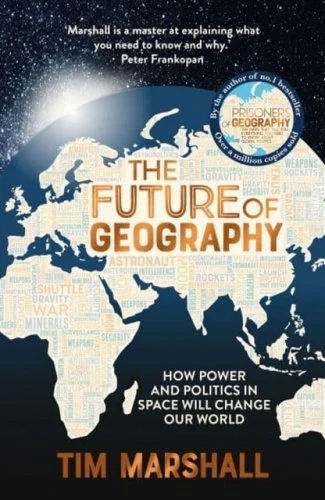Tim Marshall’s skill is to take the kind of background geography that we all get at school – things like maps, flags, mountains and rivers – and use them to explain the world. Why some countries are always fought over, or why some places struggle to integrate into the global economy. His books do the joining up that we don’t always get at school: how geography intersects with history, politics and economics. Books such as Prisoners of Geography or The Power of Geography are as entertaining as they are informative, and they deserve their status as bestsellers.
In his latest book, The Future of Geography, Marshall directs our attention outwards. Space is also geography, he points out. Although it may not look it, there are trade routes and pinch points. There is strategic high ground. With a new space race well underway, we are entering an era of astropolitics.
We begin with a historical overview of humanity’s relationship with space, from early efforts to map the movements of the planets, to the development of telescopes. Even this was political, with the Catholic church wielding a literal interpretation of the Bible against those who claimed the earth wasn’t the centre of the universe. One Italian astronomer was burned at the stake. Others quickly learned to qualify their statements with maybes and possiblies that they could fall back on in court.
Humanity’s first journeys into space were just as politicised, albeit with very different power structures. Soviet and American competition animated the space programmes of the 20th century, before giving way to a more cooperative approach with the end of the Cold War. The International Space Station is the primary achievement of that era, hosting astronauts from dozens of countries.
It’s the breakdown of that cooperation that has moved us into another round of competition. A combination of nationalism and mistrust led the US Congress to ban NASA from collaborating with China, making rivalry inevitable. Russia’s aggressions ended decades of cooperation on science, and the field has now splintered into three main space powers.
Marshall dedicates a chapter to each of them, looking at their past successes, their current capabilities and their future plans. Russia’s glories are probably behind them. China’s are still to come, while the USA has the historical bragging rights and a certain sense of entitlement when it comes to space.
Beyond these three are a range of other national space programmes and regional blocs. The most significant is the European Space Agency, which is freely able to collaborate with anyone it chooses and is more interested in science than big statement projects. India has ambitions. The African Union is aiming to bring together the various national programmes into something larger. And then you’ve got the private companies: the ones owned by billionaires with big hats, and lots of others too, including some in China.
One thing that I found interesting is the contrasting cultures around space. Because Americans dominate popular culture, so does their view of space as an extension of America’s frontier myth: space is all about outward human expansion. Not everyone sees it that way. For China, it’s much more about bringing the benefits of space back to earth.
The book examines the Chinese sci-fi movie The Wandering Earth as an example. Rather than flee a cosmic risk to the planet, they move the planet and take everybody with them. Obviously I went and watched it straight away, and Marshall is right. The Wandering Earth is distinctively different in tone from Hollywood sci-fi, just as movies like Crouching Tiger, Hidden Dragon are distinct from American superhero tales.
Chinese spacefarers are called Taikonauts, by the way. My 11 year old knew this already.
Less happily, the book concludes with chapters on space warfare. “Each time humanity has ventured into a new domain it has brought war with it,” Marshall observes. “Shipbuilding resulted in warships. Aeroplanes brought fighter jets and bombers. Space is no different and the potential battlefield is beginning to take shape.”
There are some tentative treaties on how we might break this cycle, setting out who can own what and what can and can’t be done in space. None of the three main powers have signed those treaties, and the billionaires actively scorn them in a way that makes them look bold and freedom-loving to some, and naïve and cavalier to others. Tensions over orbits, access rights, and satellite weaponry are already simmering.
One way to avoid this sparking into outright conflict is to widen the number of people who understand and take an interest in astropolitics. The Future of Geography is a good place to start.
- You can pick up The Future of Geography from Earthbound Books UK or US

